Critical Evaluation: Fall Incidence at Hazelwood Care Home, Unit 18
VerifiedAdded on 2023/01/12
|28
|7742
|94
Report
AI Summary
This report presents an action research study conducted at Hazelwood Care Home, critically evaluating the incidence of falls as a safeguarding issue. The study begins with an introduction outlining the background, research aim, and objectives, followed by a comprehensive literature review that explores the incidence of falls, associated risk factors, and challenges faced by healthcare practitioners in preventing falls. The research methodology section details the qualitative research approach, interpretivism philosophy, and descriptive research design used to gather data from 10 healthcare practitioners through random probabilistic sampling. The report then presents the findings of the data analysis, discussing the identified themes and patterns related to fall incidence. The discussion section analyzes the findings in relation to the literature review and highlights the key issues and insights. Finally, the report concludes with recommendations for reducing fall incidence and improving patient safety, alongside a reflection on the research process and ethical considerations.
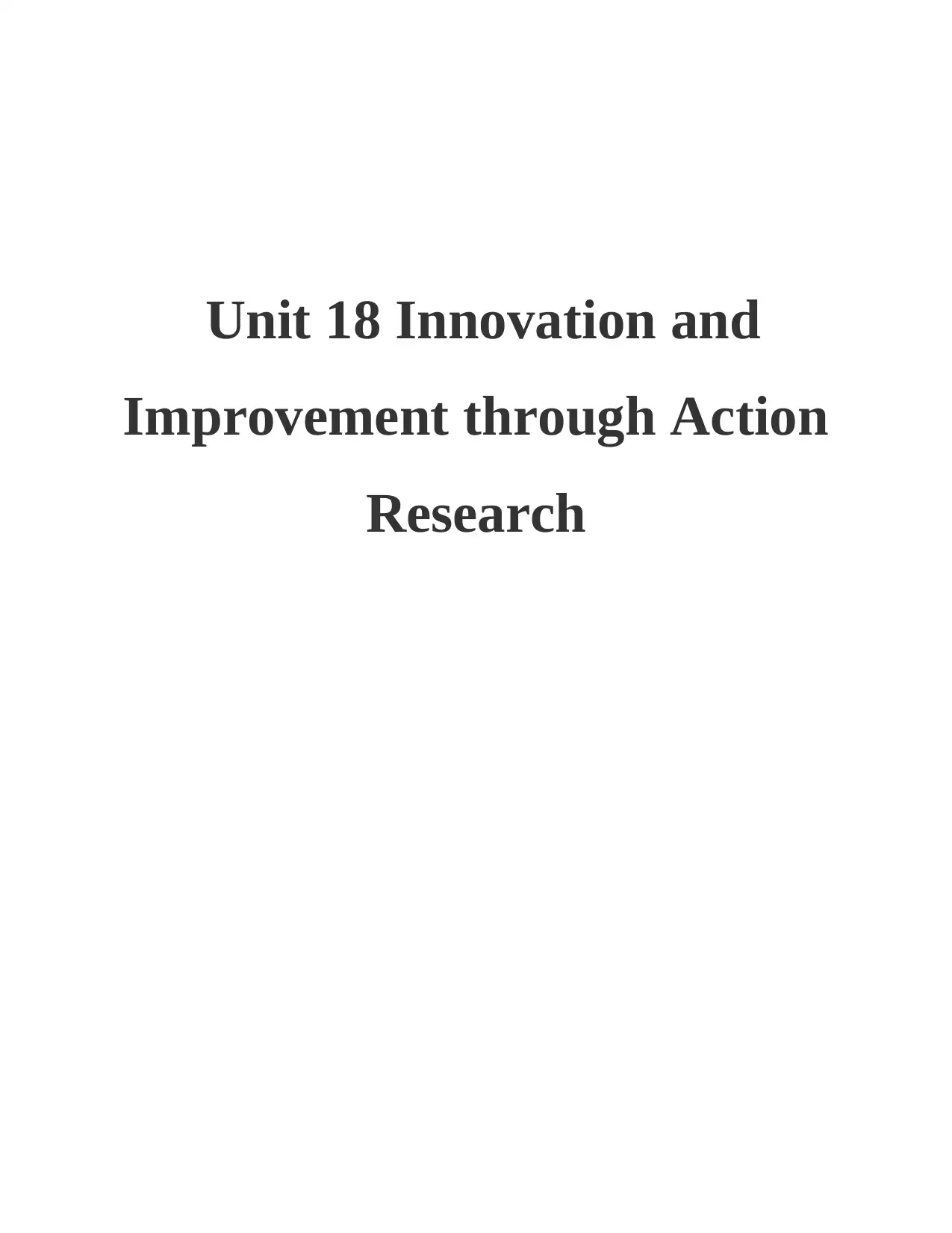
Unit 18 Innovation and
Improvement through Action
Research
Improvement through Action
Research
Paraphrase This Document
Need a fresh take? Get an instant paraphrase of this document with our AI Paraphraser
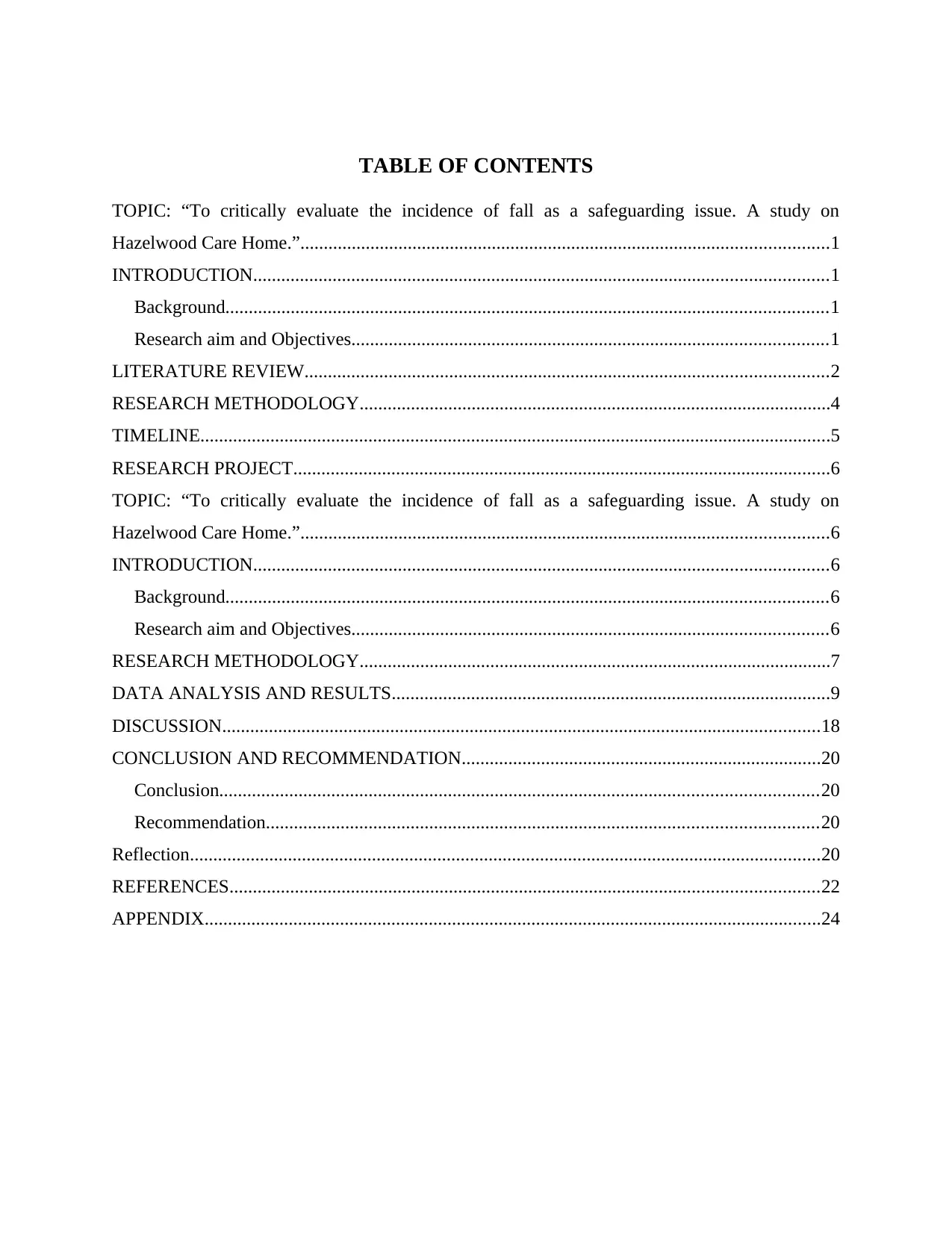
TABLE OF CONTENTS
TOPIC: “To critically evaluate the incidence of fall as a safeguarding issue. A study on
Hazelwood Care Home.”.................................................................................................................1
INTRODUCTION...........................................................................................................................1
Background.................................................................................................................................1
Research aim and Objectives......................................................................................................1
LITERATURE REVIEW................................................................................................................2
RESEARCH METHODOLOGY.....................................................................................................4
TIMELINE.......................................................................................................................................5
RESEARCH PROJECT...................................................................................................................6
TOPIC: “To critically evaluate the incidence of fall as a safeguarding issue. A study on
Hazelwood Care Home.”.................................................................................................................6
INTRODUCTION...........................................................................................................................6
Background.................................................................................................................................6
Research aim and Objectives......................................................................................................6
RESEARCH METHODOLOGY.....................................................................................................7
DATA ANALYSIS AND RESULTS..............................................................................................9
DISCUSSION................................................................................................................................18
CONCLUSION AND RECOMMENDATION.............................................................................20
Conclusion................................................................................................................................20
Recommendation......................................................................................................................20
Reflection.......................................................................................................................................20
REFERENCES..............................................................................................................................22
APPENDIX....................................................................................................................................24
TOPIC: “To critically evaluate the incidence of fall as a safeguarding issue. A study on
Hazelwood Care Home.”.................................................................................................................1
INTRODUCTION...........................................................................................................................1
Background.................................................................................................................................1
Research aim and Objectives......................................................................................................1
LITERATURE REVIEW................................................................................................................2
RESEARCH METHODOLOGY.....................................................................................................4
TIMELINE.......................................................................................................................................5
RESEARCH PROJECT...................................................................................................................6
TOPIC: “To critically evaluate the incidence of fall as a safeguarding issue. A study on
Hazelwood Care Home.”.................................................................................................................6
INTRODUCTION...........................................................................................................................6
Background.................................................................................................................................6
Research aim and Objectives......................................................................................................6
RESEARCH METHODOLOGY.....................................................................................................7
DATA ANALYSIS AND RESULTS..............................................................................................9
DISCUSSION................................................................................................................................18
CONCLUSION AND RECOMMENDATION.............................................................................20
Conclusion................................................................................................................................20
Recommendation......................................................................................................................20
Reflection.......................................................................................................................................20
REFERENCES..............................................................................................................................22
APPENDIX....................................................................................................................................24
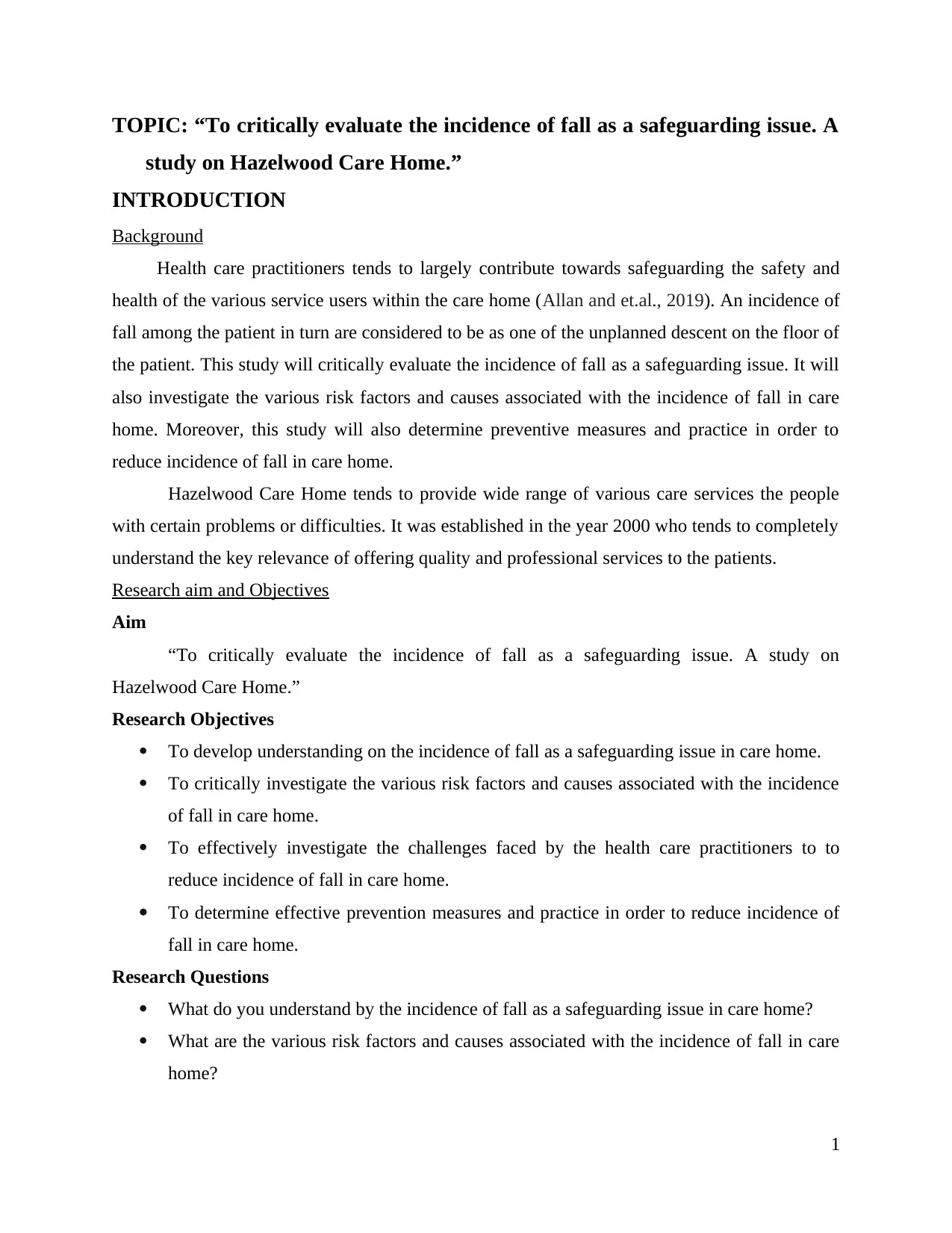
TOPIC: “To critically evaluate the incidence of fall as a safeguarding issue. A
study on Hazelwood Care Home.”
INTRODUCTION
Background
Health care practitioners tends to largely contribute towards safeguarding the safety and
health of the various service users within the care home (Allan and et.al., 2019). An incidence of
fall among the patient in turn are considered to be as one of the unplanned descent on the floor of
the patient. This study will critically evaluate the incidence of fall as a safeguarding issue. It will
also investigate the various risk factors and causes associated with the incidence of fall in care
home. Moreover, this study will also determine preventive measures and practice in order to
reduce incidence of fall in care home.
Hazelwood Care Home tends to provide wide range of various care services the people
with certain problems or difficulties. It was established in the year 2000 who tends to completely
understand the key relevance of offering quality and professional services to the patients.
Research aim and Objectives
Aim
“To critically evaluate the incidence of fall as a safeguarding issue. A study on
Hazelwood Care Home.”
Research Objectives
To develop understanding on the incidence of fall as a safeguarding issue in care home.
To critically investigate the various risk factors and causes associated with the incidence
of fall in care home.
To effectively investigate the challenges faced by the health care practitioners to to
reduce incidence of fall in care home.
To determine effective prevention measures and practice in order to reduce incidence of
fall in care home.
Research Questions
What do you understand by the incidence of fall as a safeguarding issue in care home?
What are the various risk factors and causes associated with the incidence of fall in care
home?
1
study on Hazelwood Care Home.”
INTRODUCTION
Background
Health care practitioners tends to largely contribute towards safeguarding the safety and
health of the various service users within the care home (Allan and et.al., 2019). An incidence of
fall among the patient in turn are considered to be as one of the unplanned descent on the floor of
the patient. This study will critically evaluate the incidence of fall as a safeguarding issue. It will
also investigate the various risk factors and causes associated with the incidence of fall in care
home. Moreover, this study will also determine preventive measures and practice in order to
reduce incidence of fall in care home.
Hazelwood Care Home tends to provide wide range of various care services the people
with certain problems or difficulties. It was established in the year 2000 who tends to completely
understand the key relevance of offering quality and professional services to the patients.
Research aim and Objectives
Aim
“To critically evaluate the incidence of fall as a safeguarding issue. A study on
Hazelwood Care Home.”
Research Objectives
To develop understanding on the incidence of fall as a safeguarding issue in care home.
To critically investigate the various risk factors and causes associated with the incidence
of fall in care home.
To effectively investigate the challenges faced by the health care practitioners to to
reduce incidence of fall in care home.
To determine effective prevention measures and practice in order to reduce incidence of
fall in care home.
Research Questions
What do you understand by the incidence of fall as a safeguarding issue in care home?
What are the various risk factors and causes associated with the incidence of fall in care
home?
1
⊘ This is a preview!⊘
Do you want full access?
Subscribe today to unlock all pages.

Trusted by 1+ million students worldwide
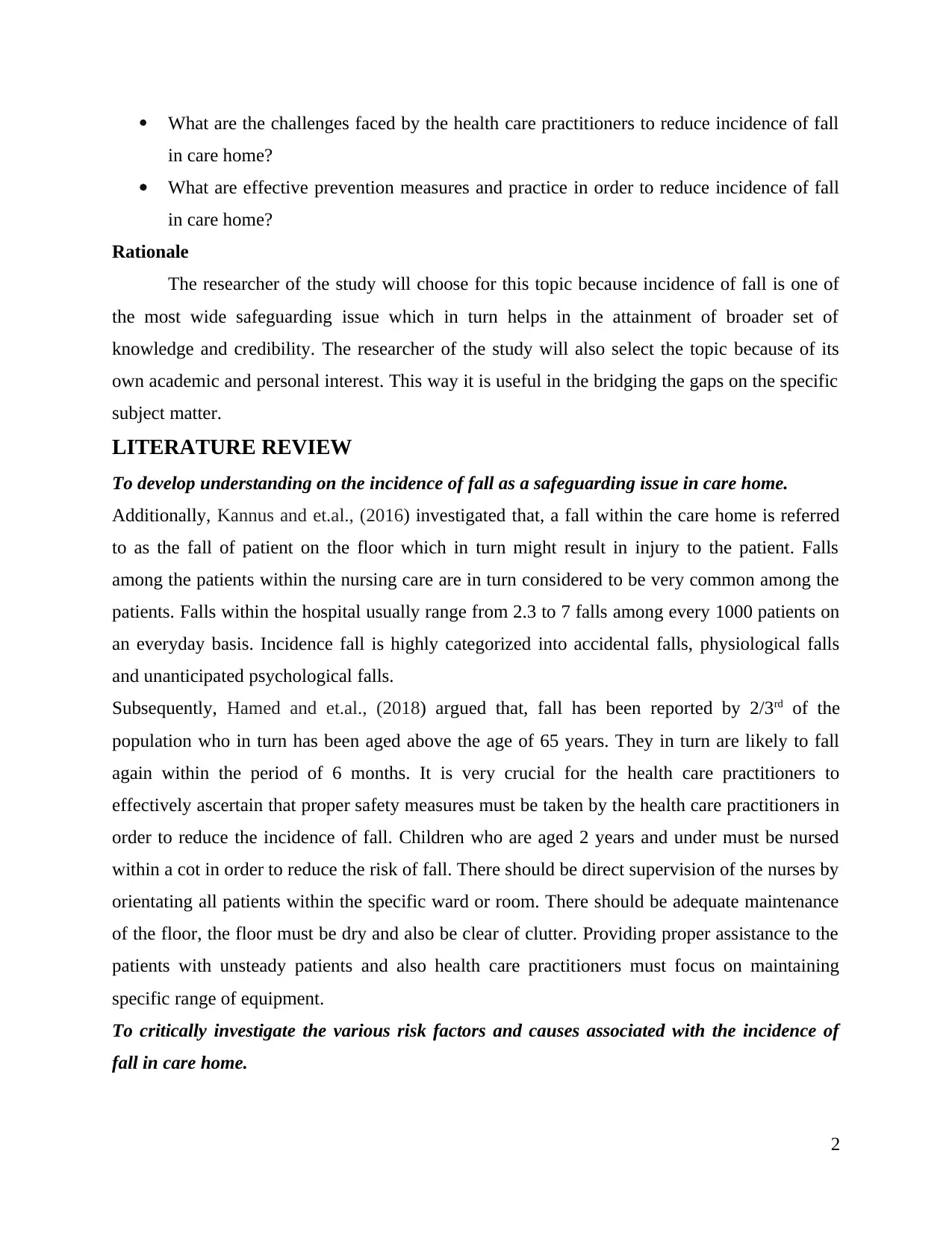
What are the challenges faced by the health care practitioners to reduce incidence of fall
in care home?
What are effective prevention measures and practice in order to reduce incidence of fall
in care home?
Rationale
The researcher of the study will choose for this topic because incidence of fall is one of
the most wide safeguarding issue which in turn helps in the attainment of broader set of
knowledge and credibility. The researcher of the study will also select the topic because of its
own academic and personal interest. This way it is useful in the bridging the gaps on the specific
subject matter.
LITERATURE REVIEW
To develop understanding on the incidence of fall as a safeguarding issue in care home.
Additionally, Kannus and et.al., (2016) investigated that, a fall within the care home is referred
to as the fall of patient on the floor which in turn might result in injury to the patient. Falls
among the patients within the nursing care are in turn considered to be very common among the
patients. Falls within the hospital usually range from 2.3 to 7 falls among every 1000 patients on
an everyday basis. Incidence fall is highly categorized into accidental falls, physiological falls
and unanticipated psychological falls.
Subsequently, Hamed and et.al., (2018) argued that, fall has been reported by 2/3rd of the
population who in turn has been aged above the age of 65 years. They in turn are likely to fall
again within the period of 6 months. It is very crucial for the health care practitioners to
effectively ascertain that proper safety measures must be taken by the health care practitioners in
order to reduce the incidence of fall. Children who are aged 2 years and under must be nursed
within a cot in order to reduce the risk of fall. There should be direct supervision of the nurses by
orientating all patients within the specific ward or room. There should be adequate maintenance
of the floor, the floor must be dry and also be clear of clutter. Providing proper assistance to the
patients with unsteady patients and also health care practitioners must focus on maintaining
specific range of equipment.
To critically investigate the various risk factors and causes associated with the incidence of
fall in care home.
2
in care home?
What are effective prevention measures and practice in order to reduce incidence of fall
in care home?
Rationale
The researcher of the study will choose for this topic because incidence of fall is one of
the most wide safeguarding issue which in turn helps in the attainment of broader set of
knowledge and credibility. The researcher of the study will also select the topic because of its
own academic and personal interest. This way it is useful in the bridging the gaps on the specific
subject matter.
LITERATURE REVIEW
To develop understanding on the incidence of fall as a safeguarding issue in care home.
Additionally, Kannus and et.al., (2016) investigated that, a fall within the care home is referred
to as the fall of patient on the floor which in turn might result in injury to the patient. Falls
among the patients within the nursing care are in turn considered to be very common among the
patients. Falls within the hospital usually range from 2.3 to 7 falls among every 1000 patients on
an everyday basis. Incidence fall is highly categorized into accidental falls, physiological falls
and unanticipated psychological falls.
Subsequently, Hamed and et.al., (2018) argued that, fall has been reported by 2/3rd of the
population who in turn has been aged above the age of 65 years. They in turn are likely to fall
again within the period of 6 months. It is very crucial for the health care practitioners to
effectively ascertain that proper safety measures must be taken by the health care practitioners in
order to reduce the incidence of fall. Children who are aged 2 years and under must be nursed
within a cot in order to reduce the risk of fall. There should be direct supervision of the nurses by
orientating all patients within the specific ward or room. There should be adequate maintenance
of the floor, the floor must be dry and also be clear of clutter. Providing proper assistance to the
patients with unsteady patients and also health care practitioners must focus on maintaining
specific range of equipment.
To critically investigate the various risk factors and causes associated with the incidence of
fall in care home.
2
Paraphrase This Document
Need a fresh take? Get an instant paraphrase of this document with our AI Paraphraser
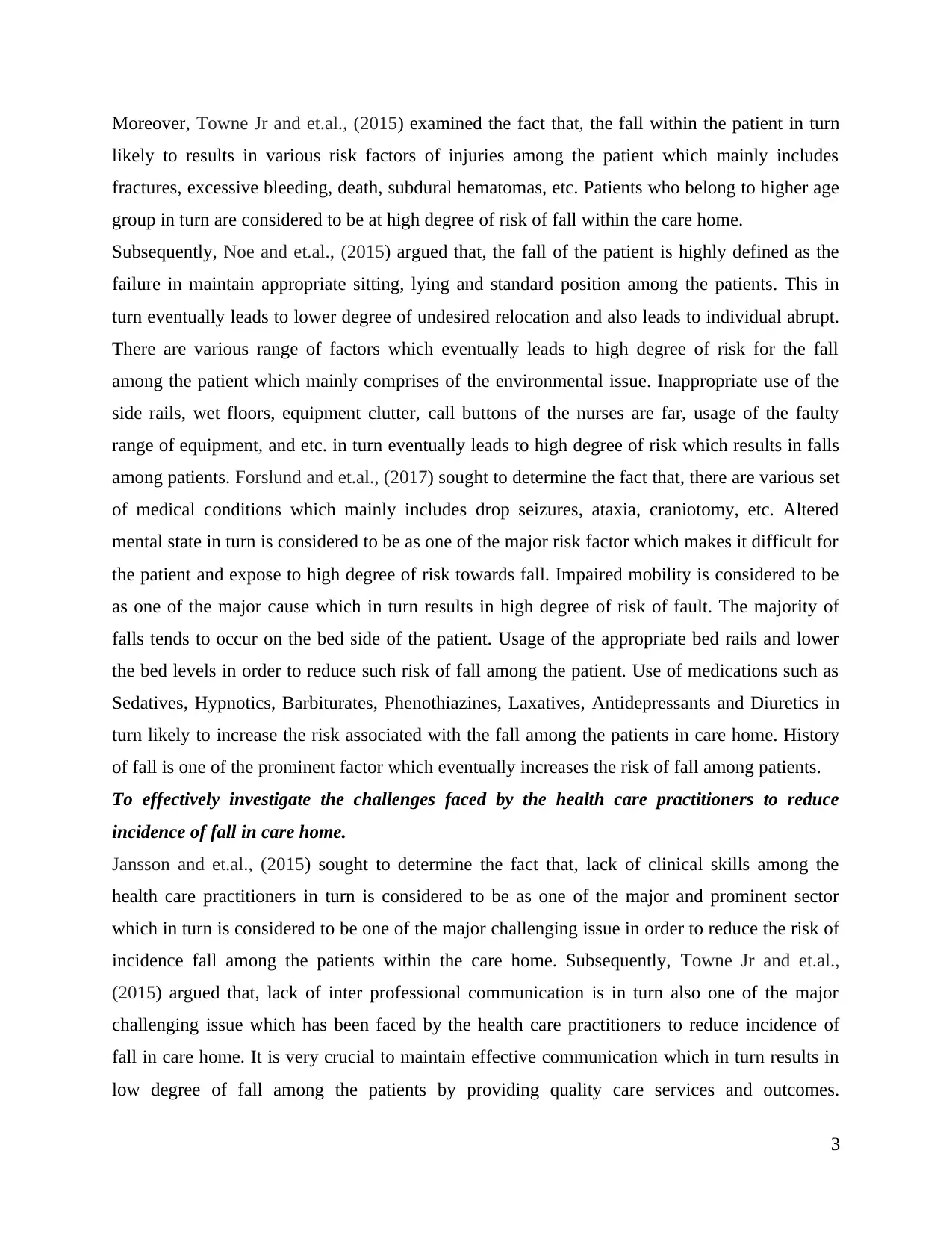
Moreover, Towne Jr and et.al., (2015) examined the fact that, the fall within the patient in turn
likely to results in various risk factors of injuries among the patient which mainly includes
fractures, excessive bleeding, death, subdural hematomas, etc. Patients who belong to higher age
group in turn are considered to be at high degree of risk of fall within the care home.
Subsequently, Noe and et.al., (2015) argued that, the fall of the patient is highly defined as the
failure in maintain appropriate sitting, lying and standard position among the patients. This in
turn eventually leads to lower degree of undesired relocation and also leads to individual abrupt.
There are various range of factors which eventually leads to high degree of risk for the fall
among the patient which mainly comprises of the environmental issue. Inappropriate use of the
side rails, wet floors, equipment clutter, call buttons of the nurses are far, usage of the faulty
range of equipment, and etc. in turn eventually leads to high degree of risk which results in falls
among patients. Forslund and et.al., (2017) sought to determine the fact that, there are various set
of medical conditions which mainly includes drop seizures, ataxia, craniotomy, etc. Altered
mental state in turn is considered to be as one of the major risk factor which makes it difficult for
the patient and expose to high degree of risk towards fall. Impaired mobility is considered to be
as one of the major cause which in turn results in high degree of risk of fault. The majority of
falls tends to occur on the bed side of the patient. Usage of the appropriate bed rails and lower
the bed levels in order to reduce such risk of fall among the patient. Use of medications such as
Sedatives, Hypnotics, Barbiturates, Phenothiazines, Laxatives, Antidepressants and Diuretics in
turn likely to increase the risk associated with the fall among the patients in care home. History
of fall is one of the prominent factor which eventually increases the risk of fall among patients.
To effectively investigate the challenges faced by the health care practitioners to reduce
incidence of fall in care home.
Jansson and et.al., (2015) sought to determine the fact that, lack of clinical skills among the
health care practitioners in turn is considered to be as one of the major and prominent sector
which in turn is considered to be one of the major challenging issue in order to reduce the risk of
incidence fall among the patients within the care home. Subsequently, Towne Jr and et.al.,
(2015) argued that, lack of inter professional communication is in turn also one of the major
challenging issue which has been faced by the health care practitioners to reduce incidence of
fall in care home. It is very crucial to maintain effective communication which in turn results in
low degree of fall among the patients by providing quality care services and outcomes.
3
likely to results in various risk factors of injuries among the patient which mainly includes
fractures, excessive bleeding, death, subdural hematomas, etc. Patients who belong to higher age
group in turn are considered to be at high degree of risk of fall within the care home.
Subsequently, Noe and et.al., (2015) argued that, the fall of the patient is highly defined as the
failure in maintain appropriate sitting, lying and standard position among the patients. This in
turn eventually leads to lower degree of undesired relocation and also leads to individual abrupt.
There are various range of factors which eventually leads to high degree of risk for the fall
among the patient which mainly comprises of the environmental issue. Inappropriate use of the
side rails, wet floors, equipment clutter, call buttons of the nurses are far, usage of the faulty
range of equipment, and etc. in turn eventually leads to high degree of risk which results in falls
among patients. Forslund and et.al., (2017) sought to determine the fact that, there are various set
of medical conditions which mainly includes drop seizures, ataxia, craniotomy, etc. Altered
mental state in turn is considered to be as one of the major risk factor which makes it difficult for
the patient and expose to high degree of risk towards fall. Impaired mobility is considered to be
as one of the major cause which in turn results in high degree of risk of fault. The majority of
falls tends to occur on the bed side of the patient. Usage of the appropriate bed rails and lower
the bed levels in order to reduce such risk of fall among the patient. Use of medications such as
Sedatives, Hypnotics, Barbiturates, Phenothiazines, Laxatives, Antidepressants and Diuretics in
turn likely to increase the risk associated with the fall among the patients in care home. History
of fall is one of the prominent factor which eventually increases the risk of fall among patients.
To effectively investigate the challenges faced by the health care practitioners to reduce
incidence of fall in care home.
Jansson and et.al., (2015) sought to determine the fact that, lack of clinical skills among the
health care practitioners in turn is considered to be as one of the major and prominent sector
which in turn is considered to be one of the major challenging issue in order to reduce the risk of
incidence fall among the patients within the care home. Subsequently, Towne Jr and et.al.,
(2015) argued that, lack of inter professional communication is in turn also one of the major
challenging issue which has been faced by the health care practitioners to reduce incidence of
fall in care home. It is very crucial to maintain effective communication which in turn results in
low degree of fall among the patients by providing quality care services and outcomes.
3
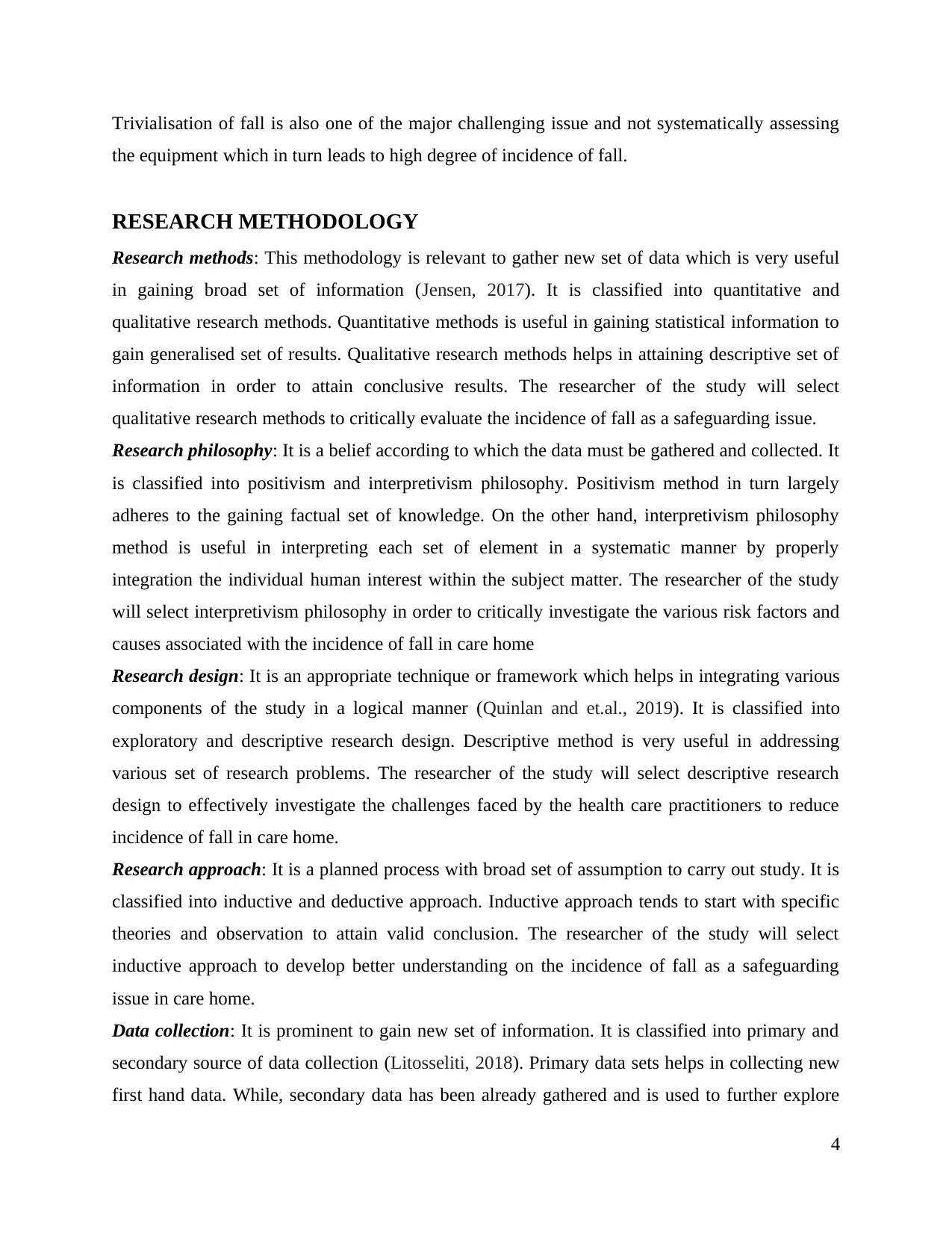
Trivialisation of fall is also one of the major challenging issue and not systematically assessing
the equipment which in turn leads to high degree of incidence of fall.
RESEARCH METHODOLOGY
Research methods: This methodology is relevant to gather new set of data which is very useful
in gaining broad set of information (Jensen, 2017). It is classified into quantitative and
qualitative research methods. Quantitative methods is useful in gaining statistical information to
gain generalised set of results. Qualitative research methods helps in attaining descriptive set of
information in order to attain conclusive results. The researcher of the study will select
qualitative research methods to critically evaluate the incidence of fall as a safeguarding issue.
Research philosophy: It is a belief according to which the data must be gathered and collected. It
is classified into positivism and interpretivism philosophy. Positivism method in turn largely
adheres to the gaining factual set of knowledge. On the other hand, interpretivism philosophy
method is useful in interpreting each set of element in a systematic manner by properly
integration the individual human interest within the subject matter. The researcher of the study
will select interpretivism philosophy in order to critically investigate the various risk factors and
causes associated with the incidence of fall in care home
Research design: It is an appropriate technique or framework which helps in integrating various
components of the study in a logical manner (Quinlan and et.al., 2019). It is classified into
exploratory and descriptive research design. Descriptive method is very useful in addressing
various set of research problems. The researcher of the study will select descriptive research
design to effectively investigate the challenges faced by the health care practitioners to reduce
incidence of fall in care home.
Research approach: It is a planned process with broad set of assumption to carry out study. It is
classified into inductive and deductive approach. Inductive approach tends to start with specific
theories and observation to attain valid conclusion. The researcher of the study will select
inductive approach to develop better understanding on the incidence of fall as a safeguarding
issue in care home.
Data collection: It is prominent to gain new set of information. It is classified into primary and
secondary source of data collection (Litosseliti, 2018). Primary data sets helps in collecting new
first hand data. While, secondary data has been already gathered and is used to further explore
4
the equipment which in turn leads to high degree of incidence of fall.
RESEARCH METHODOLOGY
Research methods: This methodology is relevant to gather new set of data which is very useful
in gaining broad set of information (Jensen, 2017). It is classified into quantitative and
qualitative research methods. Quantitative methods is useful in gaining statistical information to
gain generalised set of results. Qualitative research methods helps in attaining descriptive set of
information in order to attain conclusive results. The researcher of the study will select
qualitative research methods to critically evaluate the incidence of fall as a safeguarding issue.
Research philosophy: It is a belief according to which the data must be gathered and collected. It
is classified into positivism and interpretivism philosophy. Positivism method in turn largely
adheres to the gaining factual set of knowledge. On the other hand, interpretivism philosophy
method is useful in interpreting each set of element in a systematic manner by properly
integration the individual human interest within the subject matter. The researcher of the study
will select interpretivism philosophy in order to critically investigate the various risk factors and
causes associated with the incidence of fall in care home
Research design: It is an appropriate technique or framework which helps in integrating various
components of the study in a logical manner (Quinlan and et.al., 2019). It is classified into
exploratory and descriptive research design. Descriptive method is very useful in addressing
various set of research problems. The researcher of the study will select descriptive research
design to effectively investigate the challenges faced by the health care practitioners to reduce
incidence of fall in care home.
Research approach: It is a planned process with broad set of assumption to carry out study. It is
classified into inductive and deductive approach. Inductive approach tends to start with specific
theories and observation to attain valid conclusion. The researcher of the study will select
inductive approach to develop better understanding on the incidence of fall as a safeguarding
issue in care home.
Data collection: It is prominent to gain new set of information. It is classified into primary and
secondary source of data collection (Litosseliti, 2018). Primary data sets helps in collecting new
first hand data. While, secondary data has been already gathered and is used to further explore
4
⊘ This is a preview!⊘
Do you want full access?
Subscribe today to unlock all pages.

Trusted by 1+ million students worldwide
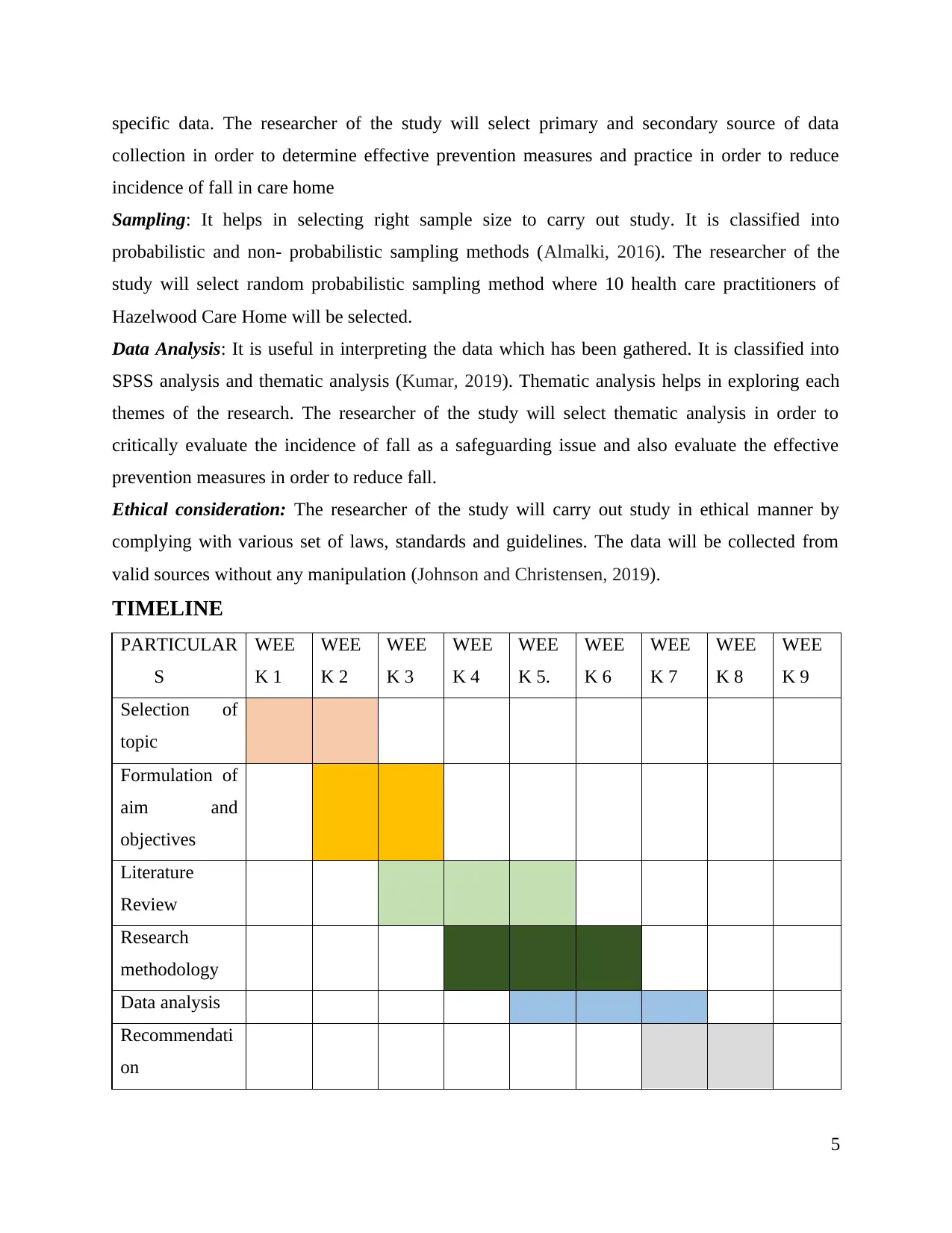
specific data. The researcher of the study will select primary and secondary source of data
collection in order to determine effective prevention measures and practice in order to reduce
incidence of fall in care home
Sampling: It helps in selecting right sample size to carry out study. It is classified into
probabilistic and non- probabilistic sampling methods (Almalki, 2016). The researcher of the
study will select random probabilistic sampling method where 10 health care practitioners of
Hazelwood Care Home will be selected.
Data Analysis: It is useful in interpreting the data which has been gathered. It is classified into
SPSS analysis and thematic analysis (Kumar, 2019). Thematic analysis helps in exploring each
themes of the research. The researcher of the study will select thematic analysis in order to
critically evaluate the incidence of fall as a safeguarding issue and also evaluate the effective
prevention measures in order to reduce fall.
Ethical consideration: The researcher of the study will carry out study in ethical manner by
complying with various set of laws, standards and guidelines. The data will be collected from
valid sources without any manipulation (Johnson and Christensen, 2019).
TIMELINE
PARTICULAR
S
WEE
K 1
WEE
K 2
WEE
K 3
WEE
K 4
WEE
K 5.
WEE
K 6
WEE
K 7
WEE
K 8
WEE
K 9
Selection of
topic
Formulation of
aim and
objectives
Literature
Review
Research
methodology
Data analysis
Recommendati
on
5
collection in order to determine effective prevention measures and practice in order to reduce
incidence of fall in care home
Sampling: It helps in selecting right sample size to carry out study. It is classified into
probabilistic and non- probabilistic sampling methods (Almalki, 2016). The researcher of the
study will select random probabilistic sampling method where 10 health care practitioners of
Hazelwood Care Home will be selected.
Data Analysis: It is useful in interpreting the data which has been gathered. It is classified into
SPSS analysis and thematic analysis (Kumar, 2019). Thematic analysis helps in exploring each
themes of the research. The researcher of the study will select thematic analysis in order to
critically evaluate the incidence of fall as a safeguarding issue and also evaluate the effective
prevention measures in order to reduce fall.
Ethical consideration: The researcher of the study will carry out study in ethical manner by
complying with various set of laws, standards and guidelines. The data will be collected from
valid sources without any manipulation (Johnson and Christensen, 2019).
TIMELINE
PARTICULAR
S
WEE
K 1
WEE
K 2
WEE
K 3
WEE
K 4
WEE
K 5.
WEE
K 6
WEE
K 7
WEE
K 8
WEE
K 9
Selection of
topic
Formulation of
aim and
objectives
Literature
Review
Research
methodology
Data analysis
Recommendati
on
5
Paraphrase This Document
Need a fresh take? Get an instant paraphrase of this document with our AI Paraphraser
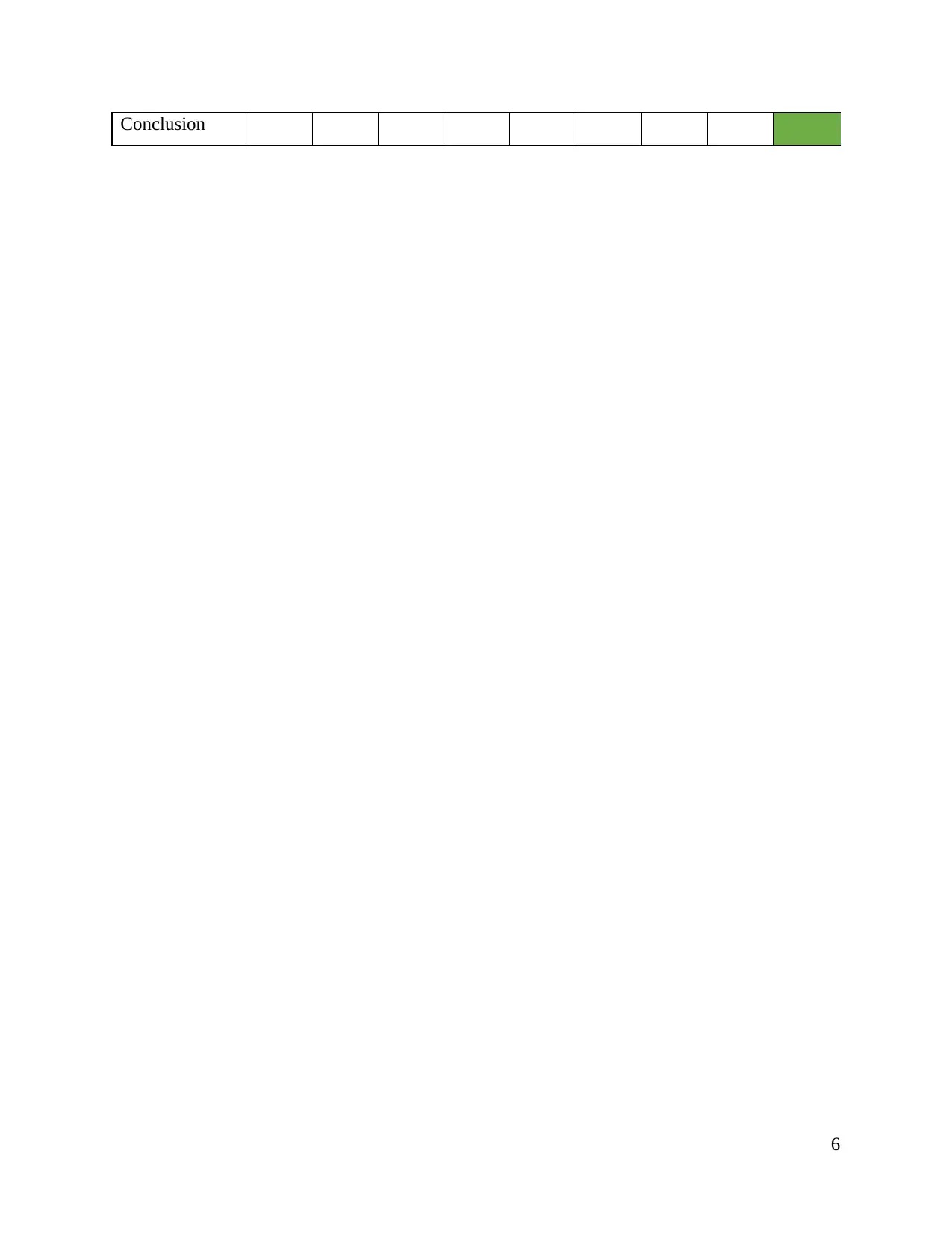
Conclusion
6
6
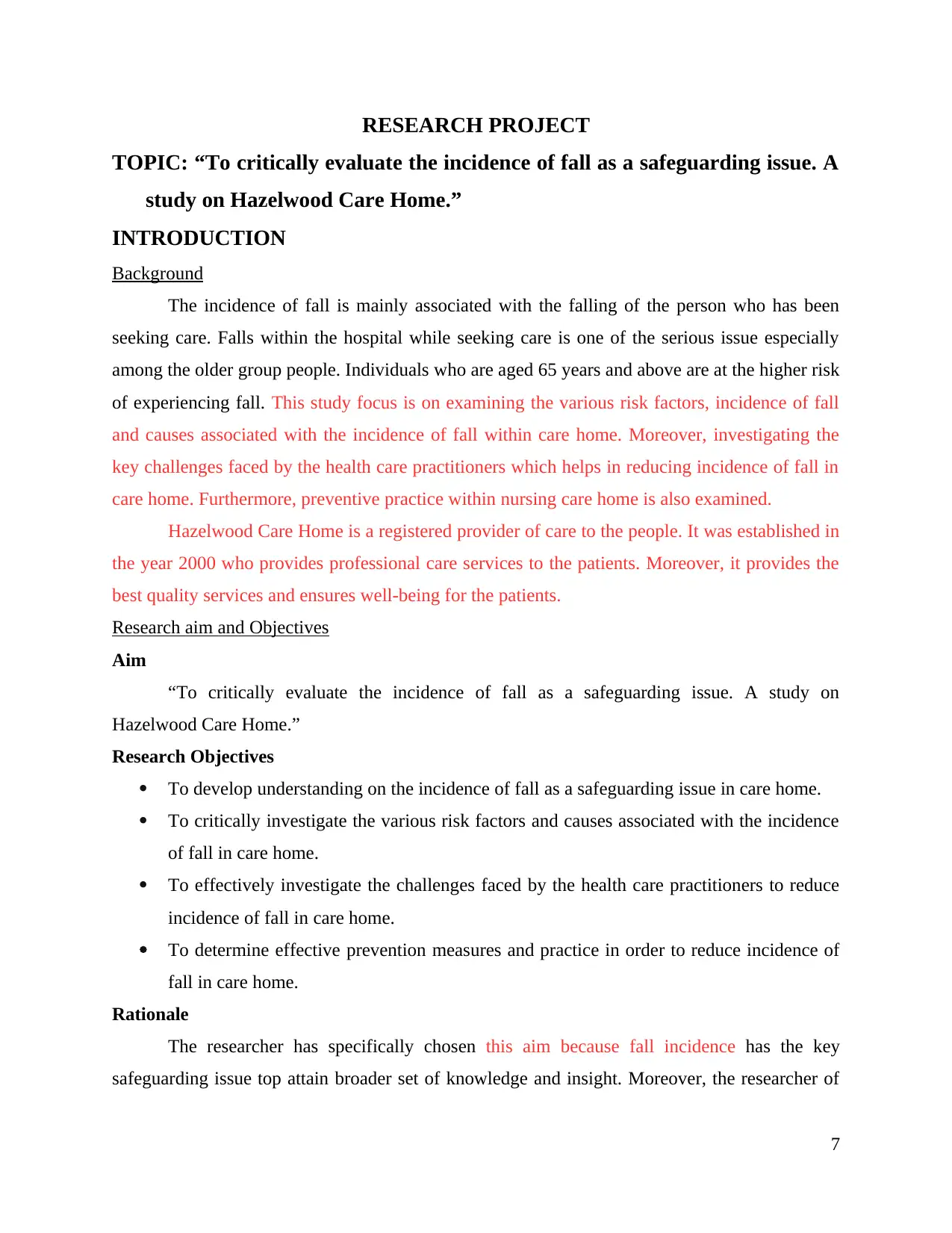
RESEARCH PROJECT
TOPIC: “To critically evaluate the incidence of fall as a safeguarding issue. A
study on Hazelwood Care Home.”
INTRODUCTION
Background
The incidence of fall is mainly associated with the falling of the person who has been
seeking care. Falls within the hospital while seeking care is one of the serious issue especially
among the older group people. Individuals who are aged 65 years and above are at the higher risk
of experiencing fall. This study focus is on examining the various risk factors, incidence of fall
and causes associated with the incidence of fall within care home. Moreover, investigating the
key challenges faced by the health care practitioners which helps in reducing incidence of fall in
care home. Furthermore, preventive practice within nursing care home is also examined.
Hazelwood Care Home is a registered provider of care to the people. It was established in
the year 2000 who provides professional care services to the patients. Moreover, it provides the
best quality services and ensures well-being for the patients.
Research aim and Objectives
Aim
“To critically evaluate the incidence of fall as a safeguarding issue. A study on
Hazelwood Care Home.”
Research Objectives
To develop understanding on the incidence of fall as a safeguarding issue in care home.
To critically investigate the various risk factors and causes associated with the incidence
of fall in care home.
To effectively investigate the challenges faced by the health care practitioners to reduce
incidence of fall in care home.
To determine effective prevention measures and practice in order to reduce incidence of
fall in care home.
Rationale
The researcher has specifically chosen this aim because fall incidence has the key
safeguarding issue top attain broader set of knowledge and insight. Moreover, the researcher of
7
TOPIC: “To critically evaluate the incidence of fall as a safeguarding issue. A
study on Hazelwood Care Home.”
INTRODUCTION
Background
The incidence of fall is mainly associated with the falling of the person who has been
seeking care. Falls within the hospital while seeking care is one of the serious issue especially
among the older group people. Individuals who are aged 65 years and above are at the higher risk
of experiencing fall. This study focus is on examining the various risk factors, incidence of fall
and causes associated with the incidence of fall within care home. Moreover, investigating the
key challenges faced by the health care practitioners which helps in reducing incidence of fall in
care home. Furthermore, preventive practice within nursing care home is also examined.
Hazelwood Care Home is a registered provider of care to the people. It was established in
the year 2000 who provides professional care services to the patients. Moreover, it provides the
best quality services and ensures well-being for the patients.
Research aim and Objectives
Aim
“To critically evaluate the incidence of fall as a safeguarding issue. A study on
Hazelwood Care Home.”
Research Objectives
To develop understanding on the incidence of fall as a safeguarding issue in care home.
To critically investigate the various risk factors and causes associated with the incidence
of fall in care home.
To effectively investigate the challenges faced by the health care practitioners to reduce
incidence of fall in care home.
To determine effective prevention measures and practice in order to reduce incidence of
fall in care home.
Rationale
The researcher has specifically chosen this aim because fall incidence has the key
safeguarding issue top attain broader set of knowledge and insight. Moreover, the researcher of
7
⊘ This is a preview!⊘
Do you want full access?
Subscribe today to unlock all pages.

Trusted by 1+ million students worldwide
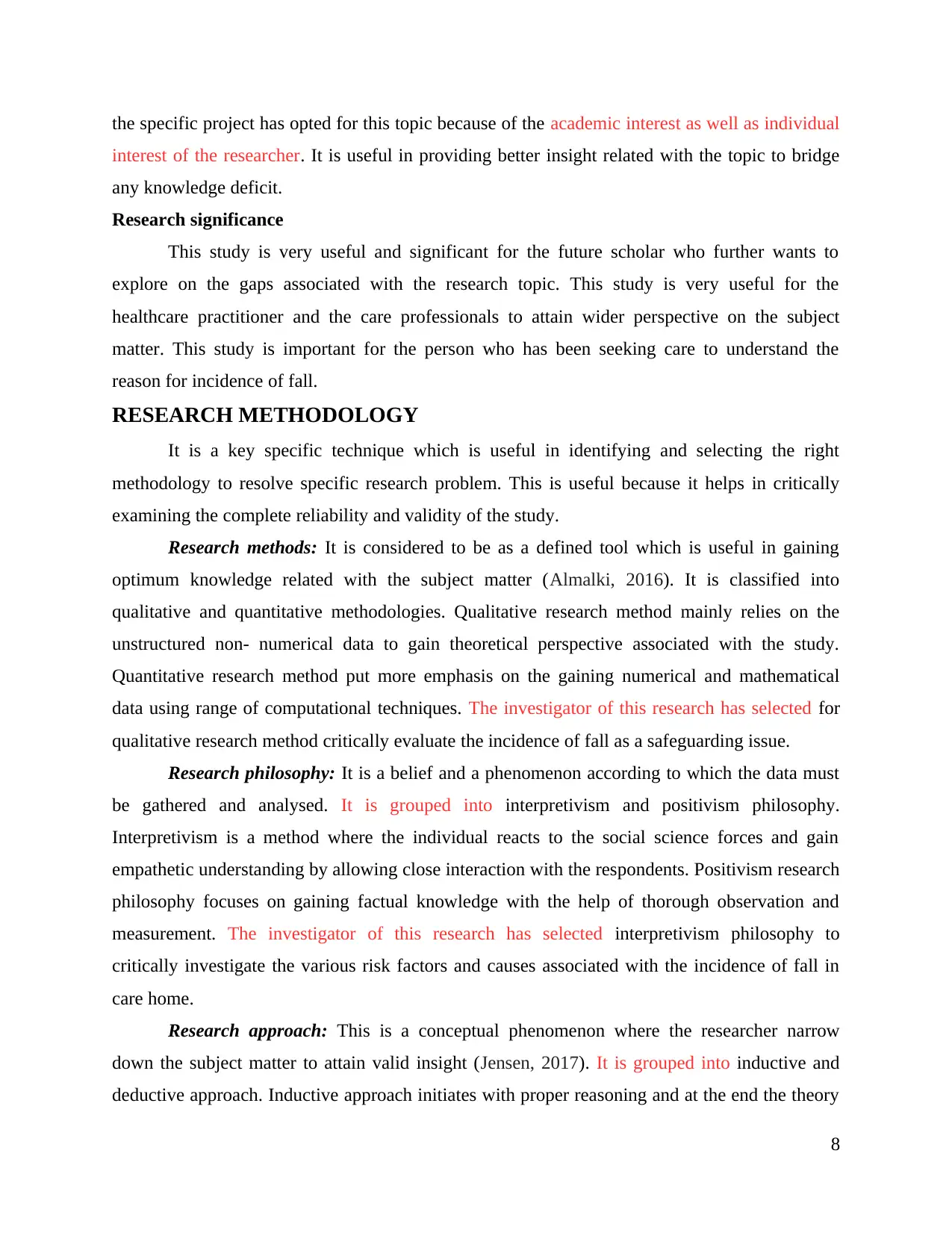
the specific project has opted for this topic because of the academic interest as well as individual
interest of the researcher. It is useful in providing better insight related with the topic to bridge
any knowledge deficit.
Research significance
This study is very useful and significant for the future scholar who further wants to
explore on the gaps associated with the research topic. This study is very useful for the
healthcare practitioner and the care professionals to attain wider perspective on the subject
matter. This study is important for the person who has been seeking care to understand the
reason for incidence of fall.
RESEARCH METHODOLOGY
It is a key specific technique which is useful in identifying and selecting the right
methodology to resolve specific research problem. This is useful because it helps in critically
examining the complete reliability and validity of the study.
Research methods: It is considered to be as a defined tool which is useful in gaining
optimum knowledge related with the subject matter (Almalki, 2016). It is classified into
qualitative and quantitative methodologies. Qualitative research method mainly relies on the
unstructured non- numerical data to gain theoretical perspective associated with the study.
Quantitative research method put more emphasis on the gaining numerical and mathematical
data using range of computational techniques. The investigator of this research has selected for
qualitative research method critically evaluate the incidence of fall as a safeguarding issue.
Research philosophy: It is a belief and a phenomenon according to which the data must
be gathered and analysed. It is grouped into interpretivism and positivism philosophy.
Interpretivism is a method where the individual reacts to the social science forces and gain
empathetic understanding by allowing close interaction with the respondents. Positivism research
philosophy focuses on gaining factual knowledge with the help of thorough observation and
measurement. The investigator of this research has selected interpretivism philosophy to
critically investigate the various risk factors and causes associated with the incidence of fall in
care home.
Research approach: This is a conceptual phenomenon where the researcher narrow
down the subject matter to attain valid insight (Jensen, 2017). It is grouped into inductive and
deductive approach. Inductive approach initiates with proper reasoning and at the end the theory
8
interest of the researcher. It is useful in providing better insight related with the topic to bridge
any knowledge deficit.
Research significance
This study is very useful and significant for the future scholar who further wants to
explore on the gaps associated with the research topic. This study is very useful for the
healthcare practitioner and the care professionals to attain wider perspective on the subject
matter. This study is important for the person who has been seeking care to understand the
reason for incidence of fall.
RESEARCH METHODOLOGY
It is a key specific technique which is useful in identifying and selecting the right
methodology to resolve specific research problem. This is useful because it helps in critically
examining the complete reliability and validity of the study.
Research methods: It is considered to be as a defined tool which is useful in gaining
optimum knowledge related with the subject matter (Almalki, 2016). It is classified into
qualitative and quantitative methodologies. Qualitative research method mainly relies on the
unstructured non- numerical data to gain theoretical perspective associated with the study.
Quantitative research method put more emphasis on the gaining numerical and mathematical
data using range of computational techniques. The investigator of this research has selected for
qualitative research method critically evaluate the incidence of fall as a safeguarding issue.
Research philosophy: It is a belief and a phenomenon according to which the data must
be gathered and analysed. It is grouped into interpretivism and positivism philosophy.
Interpretivism is a method where the individual reacts to the social science forces and gain
empathetic understanding by allowing close interaction with the respondents. Positivism research
philosophy focuses on gaining factual knowledge with the help of thorough observation and
measurement. The investigator of this research has selected interpretivism philosophy to
critically investigate the various risk factors and causes associated with the incidence of fall in
care home.
Research approach: This is a conceptual phenomenon where the researcher narrow
down the subject matter to attain valid insight (Jensen, 2017). It is grouped into inductive and
deductive approach. Inductive approach initiates with proper reasoning and at the end the theory
8
Paraphrase This Document
Need a fresh take? Get an instant paraphrase of this document with our AI Paraphraser
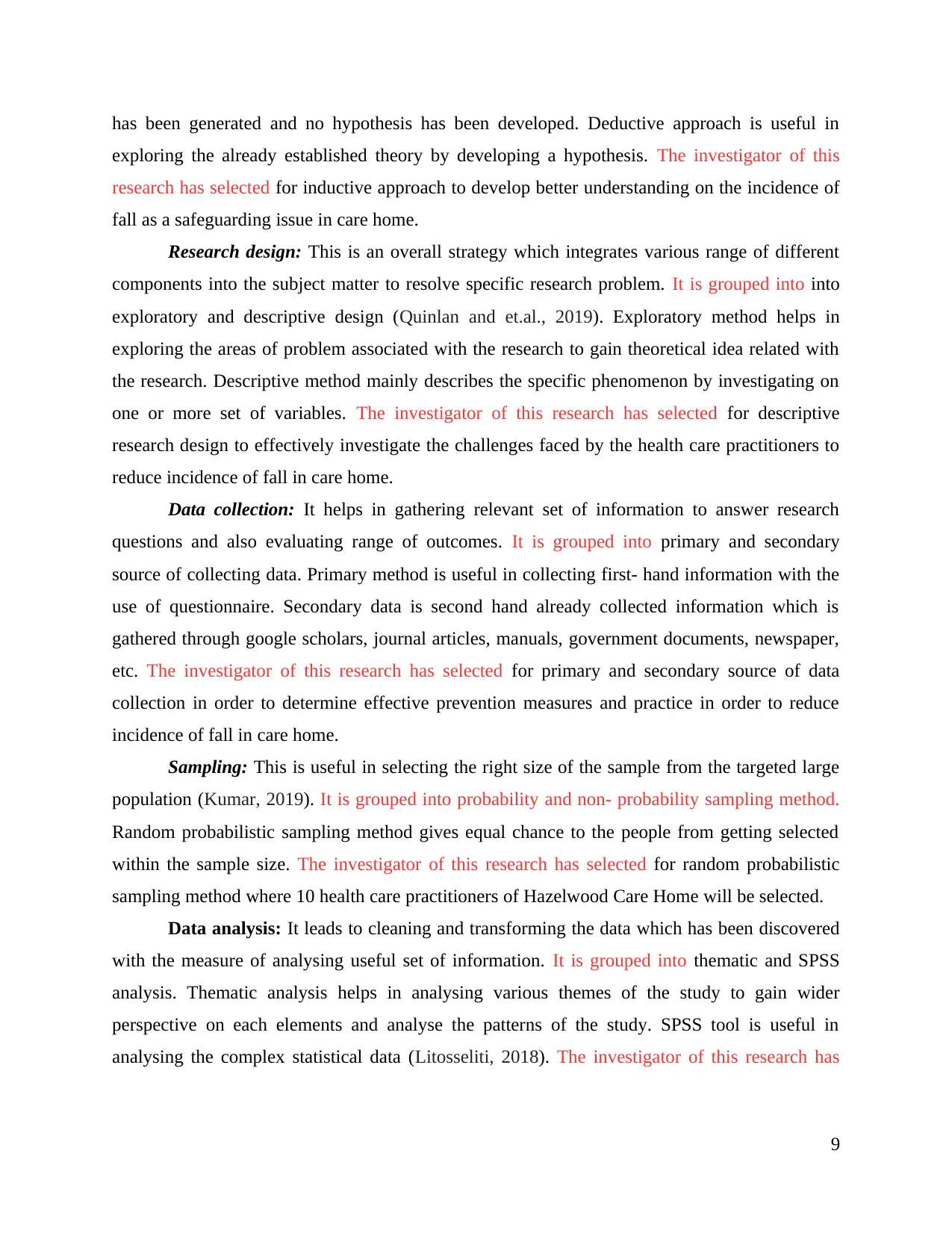
has been generated and no hypothesis has been developed. Deductive approach is useful in
exploring the already established theory by developing a hypothesis. The investigator of this
research has selected for inductive approach to develop better understanding on the incidence of
fall as a safeguarding issue in care home.
Research design: This is an overall strategy which integrates various range of different
components into the subject matter to resolve specific research problem. It is grouped into into
exploratory and descriptive design (Quinlan and et.al., 2019). Exploratory method helps in
exploring the areas of problem associated with the research to gain theoretical idea related with
the research. Descriptive method mainly describes the specific phenomenon by investigating on
one or more set of variables. The investigator of this research has selected for descriptive
research design to effectively investigate the challenges faced by the health care practitioners to
reduce incidence of fall in care home.
Data collection: It helps in gathering relevant set of information to answer research
questions and also evaluating range of outcomes. It is grouped into primary and secondary
source of collecting data. Primary method is useful in collecting first- hand information with the
use of questionnaire. Secondary data is second hand already collected information which is
gathered through google scholars, journal articles, manuals, government documents, newspaper,
etc. The investigator of this research has selected for primary and secondary source of data
collection in order to determine effective prevention measures and practice in order to reduce
incidence of fall in care home.
Sampling: This is useful in selecting the right size of the sample from the targeted large
population (Kumar, 2019). It is grouped into probability and non- probability sampling method.
Random probabilistic sampling method gives equal chance to the people from getting selected
within the sample size. The investigator of this research has selected for random probabilistic
sampling method where 10 health care practitioners of Hazelwood Care Home will be selected.
Data analysis: It leads to cleaning and transforming the data which has been discovered
with the measure of analysing useful set of information. It is grouped into thematic and SPSS
analysis. Thematic analysis helps in analysing various themes of the study to gain wider
perspective on each elements and analyse the patterns of the study. SPSS tool is useful in
analysing the complex statistical data (Litosseliti, 2018). The investigator of this research has
9
exploring the already established theory by developing a hypothesis. The investigator of this
research has selected for inductive approach to develop better understanding on the incidence of
fall as a safeguarding issue in care home.
Research design: This is an overall strategy which integrates various range of different
components into the subject matter to resolve specific research problem. It is grouped into into
exploratory and descriptive design (Quinlan and et.al., 2019). Exploratory method helps in
exploring the areas of problem associated with the research to gain theoretical idea related with
the research. Descriptive method mainly describes the specific phenomenon by investigating on
one or more set of variables. The investigator of this research has selected for descriptive
research design to effectively investigate the challenges faced by the health care practitioners to
reduce incidence of fall in care home.
Data collection: It helps in gathering relevant set of information to answer research
questions and also evaluating range of outcomes. It is grouped into primary and secondary
source of collecting data. Primary method is useful in collecting first- hand information with the
use of questionnaire. Secondary data is second hand already collected information which is
gathered through google scholars, journal articles, manuals, government documents, newspaper,
etc. The investigator of this research has selected for primary and secondary source of data
collection in order to determine effective prevention measures and practice in order to reduce
incidence of fall in care home.
Sampling: This is useful in selecting the right size of the sample from the targeted large
population (Kumar, 2019). It is grouped into probability and non- probability sampling method.
Random probabilistic sampling method gives equal chance to the people from getting selected
within the sample size. The investigator of this research has selected for random probabilistic
sampling method where 10 health care practitioners of Hazelwood Care Home will be selected.
Data analysis: It leads to cleaning and transforming the data which has been discovered
with the measure of analysing useful set of information. It is grouped into thematic and SPSS
analysis. Thematic analysis helps in analysing various themes of the study to gain wider
perspective on each elements and analyse the patterns of the study. SPSS tool is useful in
analysing the complex statistical data (Litosseliti, 2018). The investigator of this research has
9
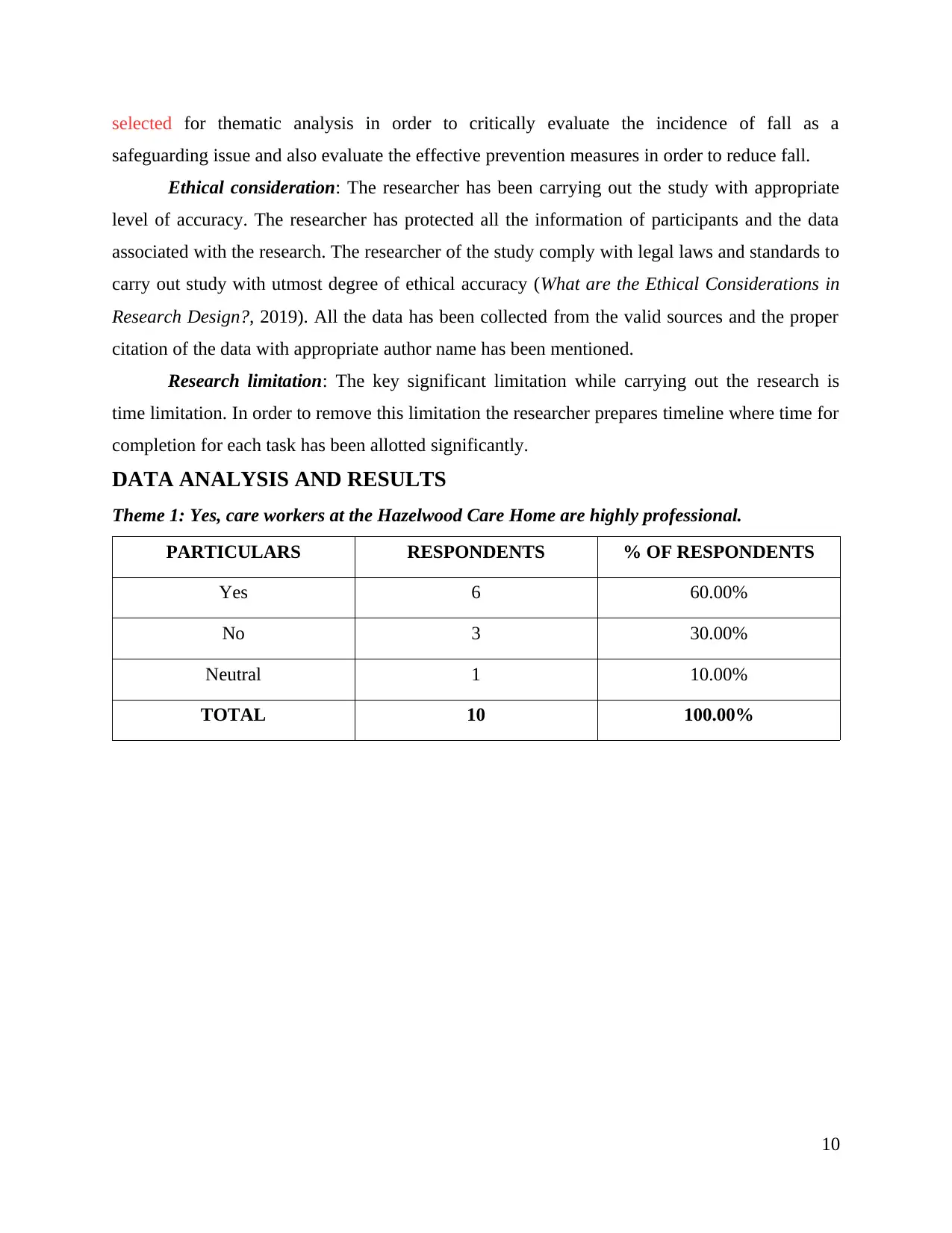
selected for thematic analysis in order to critically evaluate the incidence of fall as a
safeguarding issue and also evaluate the effective prevention measures in order to reduce fall.
Ethical consideration: The researcher has been carrying out the study with appropriate
level of accuracy. The researcher has protected all the information of participants and the data
associated with the research. The researcher of the study comply with legal laws and standards to
carry out study with utmost degree of ethical accuracy (What are the Ethical Considerations in
Research Design?, 2019). All the data has been collected from the valid sources and the proper
citation of the data with appropriate author name has been mentioned.
Research limitation: The key significant limitation while carrying out the research is
time limitation. In order to remove this limitation the researcher prepares timeline where time for
completion for each task has been allotted significantly.
DATA ANALYSIS AND RESULTS
Theme 1: Yes, care workers at the Hazelwood Care Home are highly professional.
PARTICULARS RESPONDENTS % OF RESPONDENTS
Yes 6 60.00%
No 3 30.00%
Neutral 1 10.00%
TOTAL 10 100.00%
10
safeguarding issue and also evaluate the effective prevention measures in order to reduce fall.
Ethical consideration: The researcher has been carrying out the study with appropriate
level of accuracy. The researcher has protected all the information of participants and the data
associated with the research. The researcher of the study comply with legal laws and standards to
carry out study with utmost degree of ethical accuracy (What are the Ethical Considerations in
Research Design?, 2019). All the data has been collected from the valid sources and the proper
citation of the data with appropriate author name has been mentioned.
Research limitation: The key significant limitation while carrying out the research is
time limitation. In order to remove this limitation the researcher prepares timeline where time for
completion for each task has been allotted significantly.
DATA ANALYSIS AND RESULTS
Theme 1: Yes, care workers at the Hazelwood Care Home are highly professional.
PARTICULARS RESPONDENTS % OF RESPONDENTS
Yes 6 60.00%
No 3 30.00%
Neutral 1 10.00%
TOTAL 10 100.00%
10
⊘ This is a preview!⊘
Do you want full access?
Subscribe today to unlock all pages.

Trusted by 1+ million students worldwide
1 out of 28
Related Documents
Your All-in-One AI-Powered Toolkit for Academic Success.
+13062052269
info@desklib.com
Available 24*7 on WhatsApp / Email
![[object Object]](/_next/static/media/star-bottom.7253800d.svg)
Unlock your academic potential
Copyright © 2020–2025 A2Z Services. All Rights Reserved. Developed and managed by ZUCOL.





